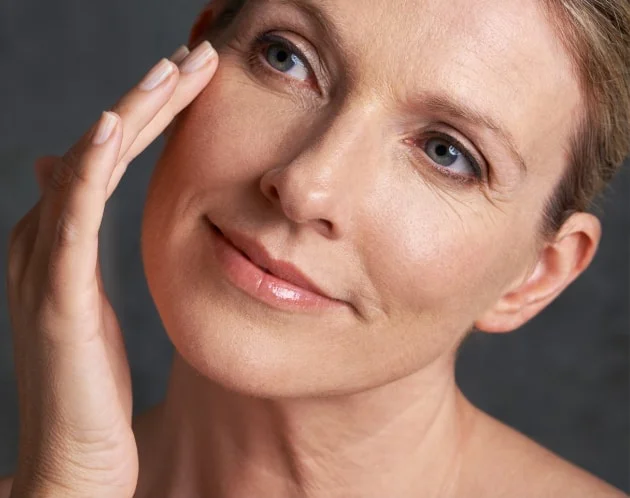The art of rhytidectomy, or a facelift, is more than simply lifting or pulling. Essential to facial rejuvenation during a rhytidectomy (facelift) is the skillful isolation, handling, and suspension of the deeper facial tissues. At the Aesthetic Institute of Oklahoma, our Oklahoma City facial plastic surgeon, Scott Shadfar, MD, allows the underlying structural anatomy to show through by sliding the tissues into the previous position they once occupied before time and gravity intervened.
Key Facelift Terms to Know
Patient education and a robust understanding of the facelift procedure are often key to obtaining a successful, satisfactory result. As you familiarize yourself with facelift surgery, we encourage you to become acquainted with common terminology you may encounter throughout your research:
- Rhytidectomy: The technical name for facelift surgery is rhytidectomy, whose literal translation is “wrinkle (rhytid-) removal (-ectomy).”
- Jowls: Refers to the loose skin or tissue that hangs along either side of the cheeks and/or jawline. Often considered a primary sign of facial aging, jowls can only be corrected with surgical procedures like a facelift.
- Nasolabial Folds: Creases that border the nose and mouth, typically extending from the nostrils to the corners of the lips. These wrinkles deepen as time goes on and may be referred to as “smile lines” or “parentheses creases.”
- Platysma Bands: Vertical bands that develop on the front and sides of the neck as we age. These cord-like bands are caused by muscles in the neck whose edges become more visible over time.
- Deep-Plane Facelift: A facelift technique designed to address all layers of the facial tissue, rather than treating just the superficial skin. Since the deep underlying tissue of the face is repositioned, results can be quite long-lasting and appear very natural.
- SMAS Facelift: A facelift procedure designed to correct the Superficial Muscular Aponeurotic System (SMAS) — a layer of tissue between the skin and subcutaneous fat. By targeting the SMAS layer, a facelift can restore lost internal support and greatly reduce jowls.

What Are Indications for Facelift and Neck Lift Surgery?
A facelift with or without a neck lift is often considered the premier method of facial rejuvenation for a broad spectrum of aesthetic concerns. The procedure is designed to target the underlying plane of musculature in addition to the superficial layer of skin, and results from surgery can last much longer than other anti-aging treatments. Indications of age that can be treated with this procedure include:
- Loose skin in the face and neck
- Jowls or sagging skin along the jawline
- Wrinkles and facial creases caused by skin laxity
- Horizontal neck bands
- Loose musculature in the neck compromising a smooth contour
A consultation can be a great opportunity to learn whether a facelift and neck lift is the most ideal treatment to help you fulfill your cosmetic goals.
What Are the Benefits of a Facelift?
A facelift offers numerous benefits. For many patients, the most prominent advantage of this treatment is its ability to produce a more youthful appearance by reducing signs of sagging skin, deep folds, and wrinkles in the lower one-third region of the face. A facelift can tighten facial muscles, enhance jawline definition, remove excess skin, and make the remaining skin firmer and smoother. Additionally, a facelift can boost an individual’s self-confidence and improve overall facial harmony. By addressing visible signs of aging, it can provide long-lasting outcomes that help individuals look and feel revitalized and rejuvenated. This surgical procedure is tailored to each patient’s unique needs and goals to create results that look natural, not artificial.
Who Is a Candidate for Facelift and/or Neck Lift Surgery?
Ideal candidates typically include women or men who are looking to refresh their facial appearance and achieve a more youthful and rejuvenated aesthetic. Facelift treatment can be a good option for patients who are experiencing signs of aging, sagging skin (such as jowls), and aesthetic concerns affecting the lower two-thirds of the face, while a neck lift can address loose skin/musculature and horizontal bands that may be affecting the appearance of the neck. Candidates must be non-smokers, in relatively good overall health, and have realistic expectations for the results of the procedure. During your initial consultation, Dr. Shadfar will evaluate your needs and help you determine the most ideal treatment option for your cosmetic enhancement goals.
How Is Facelift Surgery Performed?
Rhytidectomy is performed under deep sedation or a general anesthetic in an operating room. This allows Dr. Shadfar to access the deeper tissues through small incisions around the ears and, sometimes, a single small incision under the chin if the neck muscles need tightening as well (neck lift). Using his signature extended deep plane SMAS rhytidectomy, Dr. Shadfar can resuspend the muscular and fascial tissues that have descended over time. Simultaneously in a separate plane, he can redrape the skin in a natural position and avoid any excess tension or an unnatural, over-pulled, or “wind-swept” result.

What Is a Deep Plane Facelift?
By and large, the most rejuvenating and longest-lasting facelift outcomes typically result from a deep plane facelift. This technique repositions and alters the facial structures deep within the underlying tissues to provide a powerful, natural-looking result. As the name suggests, a deep plane facelift reaches the tissue layers within and below the SMAS layer, allowing the procedure to more comprehensively correct laxity in the face, jaw, and neck, although the technique still greatly enhances the mid-face and nasolabial folds in most patients. Due to the intricate nature of a deep plane facelift, not all plastic surgeons are adept in performing the technique. Dr. Shadfar is one of few facial plastic surgeons in Oklahoma City who is highly skilled and extensively trained in executing a deep plane facelift. By addressing the deeper tissue layers, results can last significantly longer than other facelift techniques and many patients are usually able to enjoy their refreshed appearance for years.

How Is Recovery from Facelift Surgery?
Although facelift surgery can be performed as an outpatient procedure, many of our patients elect to stay overnight with the help of our well-trained nursing staff. Once the procedure is complete, patients will wear a light, compressive head wrap for 24 hours. The following morning, patients will have the dressing removed and Dr. Shadfar will examine the operative site. We will demonstrate how to clean the incisions around the ears. The sutures will remain in place for one week. Patients can expect swelling and bruising around the surgical site, which should both resolve within the first week for the majority of individuals, and longer for combination procedures. Makeup and skincare regimens can be restarted on day 10 after the procedure. Patients usually experience minimal downtime of two weeks before returning to desk work-level activities, and we ask those who are traveling from out of town to stay for routine checks during this time period. By three weeks, we allow patients to return to exertional activities and exercise without restrictions.
How Can I Preserve the Results of Facelift Surgery?
Maintaining your skin’s health and appearance can contribute to preserved facelift surgery results. Non-surgical treatments like chemical peels and laser skin resurfacing can help improve skin texture and pigmentation, which are common cosmetic concerns that can still arise with the natural aging process. Another option is injectable dermal fillers that can help add volume and smooth out wrinkles or creases. Additionally, quality skin care can help protect your skin from harmful UV rays and improve acne or hyperpigmentation.
Are Facelift Scars Noticeable?
Facelift scars are typically minimal and well-concealed. Skilled surgeons like Dr. Shadfar usually place incisions in natural skin creases around the ears, making them less noticeable. In most cases, Dr. Shadfar needs to make a single incision under the chin when addressing the neck — he takes great care to ensure it also conceals well. Over time, scars can fade and blend in with the surrounding skin. Post-surgical care, such as proper wound care and protection from sun exposure, can further help minimize scar visibility. Advanced surgical techniques and personalized treatment plans contribute to scars that are more discreet, allowing you to enjoy a rejuvenated appearance with minimal evidence of surgery. Overall, facelift scars are generally inconspicuous and do not detract from the procedure’s aesthetic benefits.
Can I Get a Non-Surgical Facelift?
While a rhytidectomy is often considered the most effective and enduring treatment for facial aging available, Dr. Shadfar also provides an array of minimally invasive options to rejuvenate the appearance of the face without the need for surgery or downtime. Namely, a liquid facelift is designed to target common signs of age, such as fine lines and facial volume deficits, using a strategic combination of dermal fillers and injectable treatments. Wrinkles and creases can be smoothed, while a hollow look in the cheeks or tear troughs can be improved for a fuller, more youthful aesthetic. A liquid facelift often utilizes popular treatments like BOTOX® Cosmetic to address horizontal brow creases and expression lines, as well as various JUVÉDERM® products to fill in “smoker’s lines,” nasolabial folds, and sunken facial planes. Whether these non-surgical injectables are pursued as stand-alone treatments or as part of a comprehensive liquid facelift, they can offer natural-looking facial rejuvenation and relatively long-lasting results.

What Are Complementary Procedures to Facelift and Neck Lift Surgery?
Signs of age are not always confined to the lower two-thirds of the face and it is not uncommon for patients to seek adjunctive treatments for their concerns. If lax skin and creases are present in the upper third of the face and create a look of anger or stress, a forehead or brow lift may be an effective complementary procedure to smooth horizontal wrinkles and raise the eyebrows to a more youthful location. Autologous fat grafting can also be performed in conjunction with a facelift to more comprehensively address volume loss and deflation. Fat is taken from elsewhere on the patient’s body and transferred to fill out the depleted facial region.
Many individuals undergo blepharoplasty (eyelid surgery) with their rhytidectomy to tighten the skin around the eyes, minimize puffy or baggy eyelids, and achieve a more refreshed and rested appearance. Patients will often utilize dermal fillers to address the nasolabial folds and perioral region to complement their natural facelift result. For those interested in combining procedures, Dr. Shadfar can consult with you to develop the best treatment plan to make your desired aesthetic a reality.
How Do I Choose a Top Facelift Surgeon?
When it comes to plastic surgery of the face, the need for an extensively skilled plastic surgeon is more critical than ever. The face is central to how we feel about ourselves, as well as how we present ourselves to the world. For these reasons and more, it’s in your best interest to entrust your appearance, safety, and overall goals to someone who offers the highest quality of care during facelift surgery — an experienced facial plastic surgeon who has been certified by the American Board of Facial Plastic and Reconstructive Surgery (ABFPRS). Dr. Scott Shadfar specializes exclusively in surgical reconstruction of the face, head, and neck, making him an expert in reducing facial aging while attaining facial balance. Dr. Scott Shadfar is a double board-certified facial plastic surgeon and has been providing Oklahoma City with elegant, natural facelift results for many years. In addition to his expertise, he offers patients a safe, private, and fully accredited surgical facility to achieve their cosmetic goals.
Additional Frequently Asked Questions About Facelift and Neck Lift Surgery
What signs of aging can be treated?
Facelift surgery can be used to minimize the appearance of moderate to significant lines, wrinkles, folds, and creases in the lower two-thirds of the face. In addition, it can tighten lax, sagging skin and loose musculature of the face and neck that may be responsible for jowling and/or noticeable neck bands.
How do I know if I need a neck lift?
The face and neck do not age exclusively, meaning indications of laxity in the neck usually accompany signs of facial aging. More often than not, it can be advantageous to treat the face and neck simultaneously to ensure comprehensive, even rejuvenation. This is particularly true for individuals who exhibit neck wrinkling or loose, hanging skin under the chin (often known as a “turkey neck”). For this reason, Dr. Shadfar typically performs a facelift and neck lift together. However, the best way to know definitively whether you would benefit from a neck lift is to schedule a consultation with Dr. Shadfar, who can evaluate your skin quality to confirm your candidacy for the procedure.
Does a facelift for men differ from a facelift for women?
While the general techniques for a facelift are the same for all patients, men and women often have innate anatomical differences as well as distinctive aesthetic ideals. These points of contrast, as well as your individual surgical goals, may inform the procedure for both male and female patients. Above all else, Dr. Shadfar performs a facelift and neck lift to reduce facial aging while preserving the natural characteristics of each person’s face.
What age is best for a facelift and/or neck lift?
There is no definitive age that is regarded as “ideal” for facelift and/or neck lift surgery. Instead, candidacy is determined based on factors such as the severity of one’s aging concerns, the quality of their skin, and the type of results they are hoping to achieve. Generally, younger patients in their 40s undergoing a facelift will enjoy a longer-lasting result given their better skin quality.
Will my face have a “pulled” look after the procedure?
Dr. Shadfar takes great care to achieve exceptionally natural-looking facelift and neck lift results. During the procedure, he employs a special approach that enables him to lift the facial and muscular tissues in one plane, while carefully redraping the skin in a separate plane. This helps to prevent any excess pulling or tension that often results in a “wind-swept” look.
Will the incisions be noticeable?
Incisions used to perform a facelift are made discreetly around the ears (and beneath the chin if a neck lift is needed). These incisions are small in length as well as width, and carefully planned to ensure they remain as inconspicuous as possible, even when interacting with people at close distances. As part of his aim to achieve natural-appearing results, Dr. Shadfar strives to keep any evidence of surgery to a minimum.
Will there be a lot of pain?
Dr. Shadfar conducts facelift surgery under deep sedation or general anesthesia to make sure patients remain as comfortable as possible during treatment. After the procedure, any discomfort experienced is generally described as “mild” and can usually be easily controlled with medication, if necessary.
How long does it take for results to appear?
Initial results are typically apparent immediately after the procedure, although the full effect of facelift surgery will become increasingly noticeable as swelling gradually subsides over time.
How long do results last?
Facelift surgery results tend to last an average of approximately 7 to 10 years before a touch-up treatment may be desired; however, this can vary based on skin quality, lifestyle choices, and numerous other individual patient factors. The key fact to remember is this: when a facelift is performed skillfully and correctly, patients will still look younger in ten years than they would if they had never undergone treatment in the first place.
For more information about facelift or neck lift surgery contact our office today with any questions you may have, or to schedule a consultation with Dr. Shadfar.










